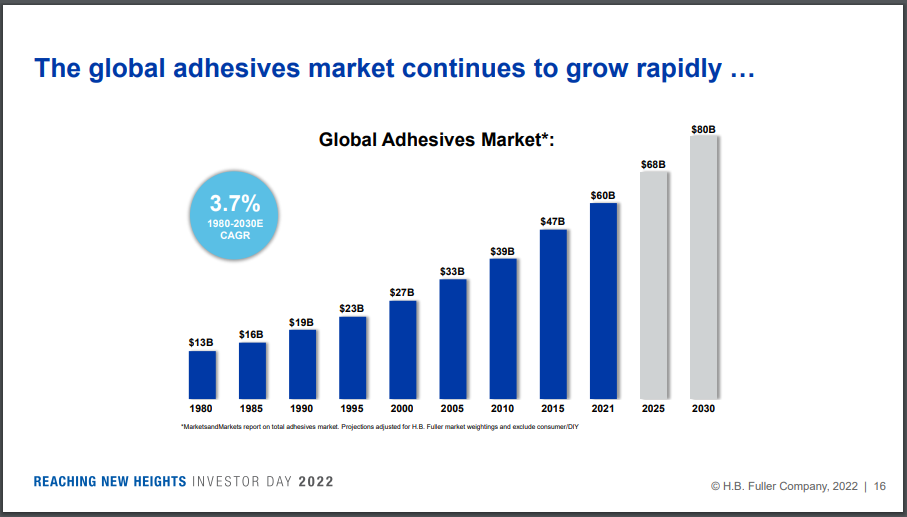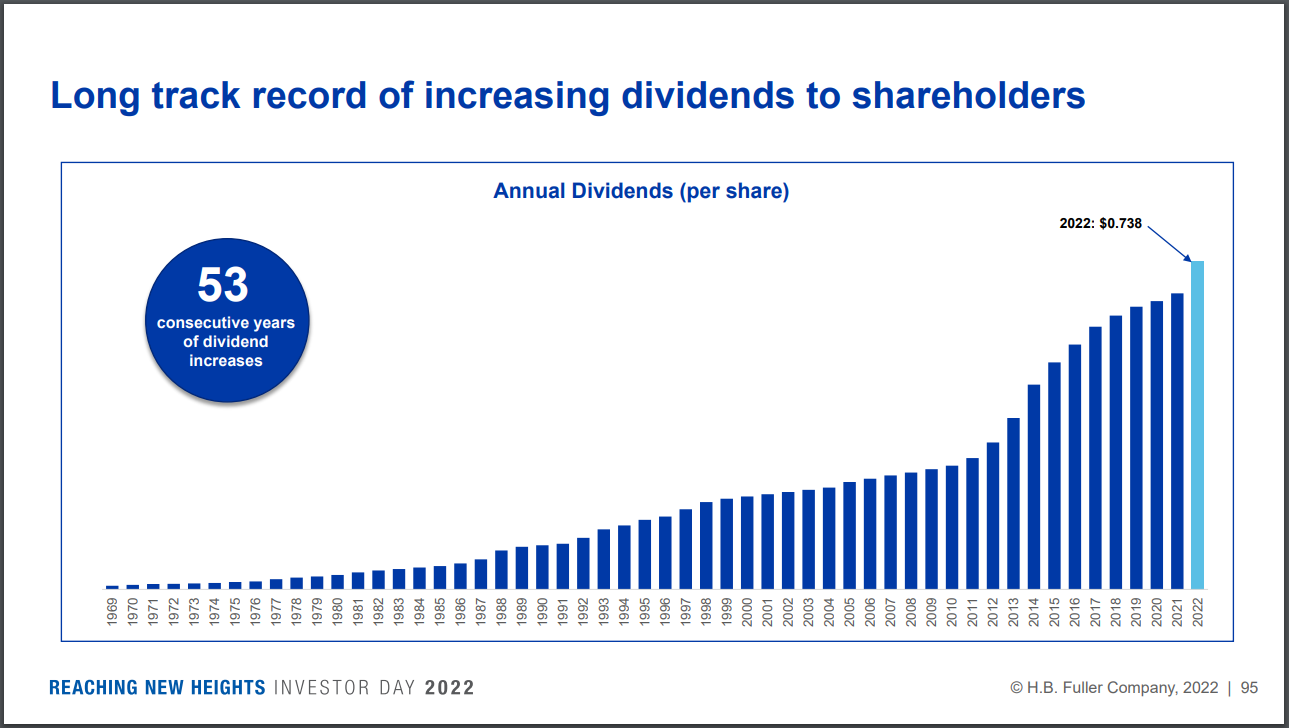Updated on September 8th, 2023 by Nikolaos Sismanis
H.B. Fuller (FUL) has increased its dividend for 54 years in a row. That puts the company among the elite Dividend Kings, a small group of stocks that have increased their payouts for at least 50 consecutive years. You can see the complete list of all 50 Dividend Kings here.
We have created a full list of all 50 Dividend Kings, along with important financial metrics such as price-to-earnings ratios and dividend yields. You can access the spreadsheet by clicking on the link below:
H.B. Fuller has remained a relatively small company, trading at a market capitalization of just $3.8 billion. However, a small market cap is not a negative feature when investing; quite the contrary.
Despite its small size, H.B. Fuller has promising growth prospects thanks to the growth potential of the niche market in which it operates. The stock offers a 1.1% dividend yield, which is lower than the yield of the S&P 500.
However, there is ample room for many future dividend raises thanks to a low payout ratio and the company’s growth prospects.
Business Overview
H.B. Fuller is a global market leader in adhesives, sealants, and other specialty chemical products. It has 69 manufacturing facilities and 38 technology centers and sells its products in 125 countries.
Adhesives is an exceptionally attractive niche market. Adhesives are critical materials in numerous applications, but they comprise just a small expense for H.B. Fuller’s customers. Adhesives make up less than 1% of the cost of goods for most customers.
In addition, each adhesive has unique chemistry, with most product formulations including 3-10 chemicals. It is also uneconomical for customers to switch to another supplier. Overall, H.B. Fuller’s customers have to use its essential products without paying much attention to their cost, which is minor compared to their other costs.

Source: Investor Presentation
H.B. Fuller has performed well over the past few years, with the company rebounding very strongly from the coronavirus crisis in 2020. The company earned $3.47 in adjusted earnings-per-share in 2021, which was an improvement over the company’s results even prior to the pandemic.
In 2022, adjusted earnings-per-share grew further to $4.00, a new all-time high for H.B. Fuller. This year, we expect the company’s profitability to be equally strong.
The company’s health and hygiene adhesives benefited greatly from the pandemic thanks to a steep increase in the demand for these types of products as well as packaging material and labeling. However, after eight consecutive quarters of solid growth, Q2-2023 marked the second consecutive decline in sales.
Specifically, H.B. Fuller’s revenue and organic revenue fell by 9.6% and 8.3% year-over-year, respectively. This was due to price hikes of 5.9% being more than offset by a 14.2% decline in volume decline. Lower volumes can, in turn, be attributed to weaker demand amid de-stocking actions of its customers and poor industrial demand.
The company’s top-line growth for the quarter was also affected by foreign currency translation, which reduced net revenue growth by 3.4%, and acquisitions, which increased net revenue growth by 2.1%.
Regarding its profitability, the company benefited from a boost in its adjusted gross margins, which expanded by 330 basis points to 29%. However, higher interest expenses and a strong dollar led to earnings-per-share declining by 16%, from $1.11 to $0.93 compared to last year.
Due to a slowing global economy, H.B. Fuller lowered its guidance for earnings-per-share this year from $4.10-$4.50 to $3.80-$4.20. At the midpoint, the company’s guidance implies that earnings-per-share will remain at last year’s levels.
Growth Prospects
The adhesives market has exhibited a 3.8% average annual growth rate over the last 41 years. It has become a $60+ billion market that is highly fragmented, with the top companies generating less than 35% of the total sales.

Source: Investor Presentation
Thanks to the high fragmentation of this market, there is a significant growth potential for H.B. Fuller, which has consistently been the second-largest player in the market behind Henkel.
Moreover, H.B. Fuller enjoys economies of scale that its smaller competitors cannot match, while the latter also lacks the global reach to compete directly with H.B. Fuller. As a result, H.B. Fuller will likely grow by gaining market share from its small competitors over time.
H.B. Fuller is also likely to keep growing via significant acquisitions. In 2017, it acquired Royal Adhesives & Sealants for $1.6 billion. As the value of that acquisition is two-thirds of the current market capitalization of H.B. Fuller, it is evident that the merger, the largest in the company’s history, was critical. The acquisition enhanced the product range of H.B. Fuller to more specialized adhesives and boosted its annual sales by about $735 million (32%).
Since the acquisition, H.B. Fuller has been reducing its debt load at a fast pace. When that process is complete, H.B. Fuller will shift its focus again to potential takeover targets.
H.B. Fuller has grown its earnings per share at an average annual rate of 8.7% from 2013 to 2022. Given the promising growth prospects of H.B. Fuller, we expect the company to grow its earnings per share at an 8.0% average annual rate over the next five years.
Competitive Advantages & Recession Performance
H.B. Fuller’s customers manufacture a wide range of products. Consequently, the performance of H.B. Fuller greatly depends on the prevailing economic conditions, and thus, the company is vulnerable to recessions. In the Great Recession, its earnings per share plunged 79%, from $1.68 in 2007 to $0.36 in 2008, and the stock lost two-thirds of its market capitalization in less than six months.
Still, the wide range of applications of its adhesives provides some diversification. For example, during the pandemic, strong growth in demand for health and hygiene products had mostly offset the decrease in the demand for adhesives in other categories.
Year-to-date, as of Q2 2023, the company’s revenues have taken a hit due to record demand in previous quarters easing. However, gross profits have grown, and despite higher interest expenses, net income remains strong.
Moreover, H.B. Fuller is the #1 or #2 player in most of its markets, and thus, it can endure a downturn more readily than its small competitor, thanks to its economies of scale. It is also worth noting that its top 10 customers comprise a relatively small amount of its revenue, and thus, the company has limited risk from any specific customer.
Finally, it is impressive that an industrial manufacturer closely tied to the underlying economic growth has raised its dividend for 54 consecutive years. This is a testament to this niche market’s strong growth and the company’s excellent business execution. H.B. Fuller has achieved this exceptional dividend growth record partly thanks to its low payout ratio.

Source: Investor Presentation
The company has always targeted a payout ratio of around 25% and thus has been able to keep raising its dividend even in years when its earnings have temporarily plunged. Due to the low payout ratio, the dividend is safe, but the resultant 1.1% dividend yield is lackluster.
Valuation & Expected Returns
H.B. Fuller is currently trading at 17.8 times its expected earnings per share of $4.00 this year. While the historical earnings multiple of the stock is 16.8, we believe that a fair price-to-earnings ratio is 15.0 due to the cyclical nature of the stock. If the stock reaches our fair valuation level over the next five years, it will suffer a 3.3% annualized headwind in its returns.
Given 8% expected earnings-per-share growth, the 1.1% dividend, and a -3.3% impact of an expanding price-to-earnings multiple, we expect H.B. Fuller to offer a 5.5% average annual return over the next five years. This rate of return earns FUL a hold recommendation at this time.
Final Thoughts
H.B. Fuller is highly vulnerable to recessions, but it has proved markedly resilient during the pandemic, thanks to a strong increase in adhesives demand used in health and hygiene products.
Moreover, thanks to the reliable long-term growth of its niche market and its high fragmentation, H.B. Fuller is likely to grow its earnings per share at a high single-digit rate in the upcoming years.
However, the company also appears to be slightly overvalued, while the 1.1% dividend yield is not that compelling. As a result, we are somewhat neutral on H.B. Fuller.
The following articles contain stocks with very long dividend or corporate histories, ripe for selection for dividend growth investors:
Thanks for reading this article. Please send any feedback, corrections, or questions to [email protected].















